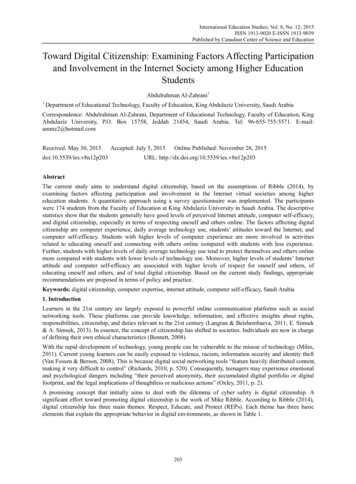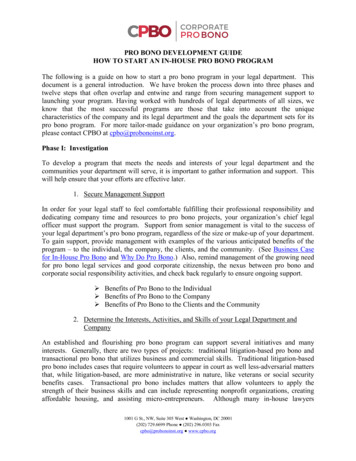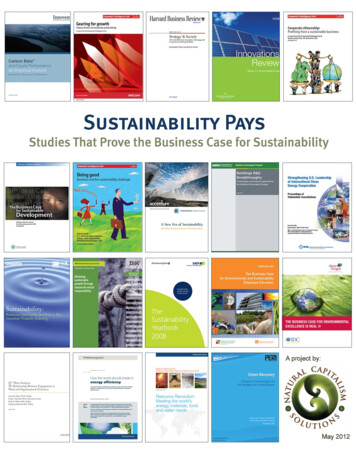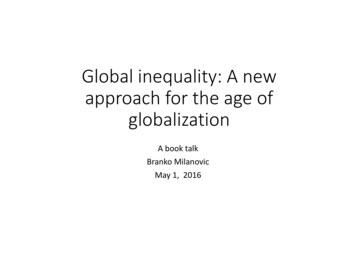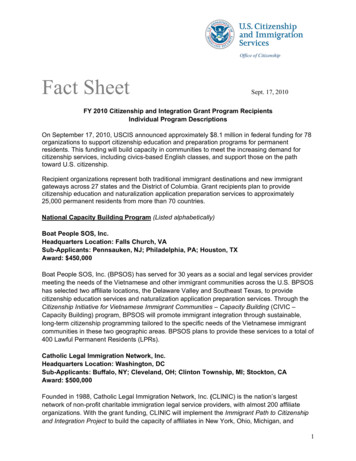
Transcription
Corporate citizenship:Profiting from a sustainable businessA report from the Economist Intelligence UnitSponsored by Cisco, HP, Qualcomm, SASand Abbott, UTC
Economist Intelligence Unit Limited 2008Corporate citizenship:Profiting from a sustainable businessContentsPreface2Executive summary4Introduction: the business case5From fringe to core9Doing good, American style11How to profit from corporate citizenship15Conclusion22Appendix: Survey results241
Corporate citizenship:Profiting from a sustainable business Economist Intelligence Unit Limited 2008PrefaceCorporate citizenship: profiting from a sustainable business is an Economist Intelligence Unit report.Lead sponsors are Cisco, HP, Qualcomm and SAS. The supporting sponsors are Abbott and UTC.The findings and views expressed in this report do not necessarily reflect the views of the sponsors.The Economist Intelligence Unit’s editorial team executed the survey, conducted the interviews and wrotethe report. Kim Andreasson was the editor and project manager. Bob Johnstone was the author. Kevin“Kal” Kallaugher created the cover image.The quantitative findings presented in this report come from an online survey of 566 US-basedexecutives—39% at vice-presidential level or above—conducted by the Economist Intelligence Unit inSeptember 2008. The survey asked respondents about their corporate citizenship initiatives and theirstrategies for benefiting from them. To supplement the quantitative survey results, we also conductedin-depth individual interviews with 16 senior executives and experts in corporate citizenship.Our thanks are due to all survey respondents and interviewees for their time and insights.November 20082
Economist Intelligence Unit Limited 2008List of intervieweesTralance Addy, chief executive officer (CEO), WaterHealthInternationalJohn Elkington, founder, SustainAbilityCorporate citizenship:Profiting from a sustainable businessJane Nelson, director, Corporate Social ResponsibilityInitiative, Harvard UniversityPat Penman, vice-president, global environmental andsafety actions, SC JohnsonDawn Rittenhouse, director, sustainable development,DuPontStuart Hart, director, Center for Sustainable GlobalEnterprise, Cornell UniversityJim Rogers, CEO, Duke EnergyFred Krupp, president, Environmental DefenseMark Tercek, CEO, The Nature ConservancyStan Litow, vice-president, corporate citizenship andcorporate affairs, IBMBrian Walker, CEO, Herman MillerPaul Tebo, president, The Tebo GroupKeith Miller, manager, environmental health & safety, 3MMark Walker, director, global community affairs, AppliedMaterialsPaul Murray, director, environmental health and safety,Herman MillerPeter White, director, global sustainability, Procter &GambleAbout the surveyIn order to assess attitudes towards corporatecitizenship in America, the Economist IntelligenceUnit conducted an online survey of 566 US-basedexecutives in September 2008. Thirty-nine percentof survey respondents describe themselves as boardmembers, C-level executives or vice-presidents. Aboutone-third (29%) work for publicly listed institutions.And 39% work for companies with global annualrevenue exceeding US 500m. More than 17 differentindustries are represented in the survey sample, ledby respondents from educational institutions (14%),information technology (IT) and technology (12%),consumer goods (9%), financial services (8%) andprofessional services (8%). Respondents also comefrom a wide variety of functions, including generalmanagement (17%), IT (14%), customer service(13%), finance (9%), and research & development(8%). Overall, 19% of respondents who know theanswer say that their company invests more thanUS 1m in corporate citizenship initiatives annually.Despite the economic malaise in 2008, five years fromnow 49% of those who say they know the answer saythat they will spend more.3
Corporate citizenship:Profiting from a sustainable business Economist Intelligence Unit Limited 2008Executive summaryCorporate citizenship is becoming increasingly important to business sustainability. It provides benefitsthat are both tangible—such as reducing waste and increasing energy efficiency—and intangible—suchas improved employee productivity. This report is based on the hypothesis that corporate citizenship canhelp to improve the bottom line.Many firms view corporate citizenship as little more than public relations, but a minority are beginningto recognise its potential. Leading companies have moved from a do-no-harm, reactive mode to a moreproactive approach. For more than a decade US firms like DuPont, 3M and SC Johnson have been showingthe way, using corporate citizenship as a source of competitive advantage. In recent years they have beenjoined by corporations like GE and Wal-Mart.The strategy is characterised as much by a hunger for new business opportunities as by the urge todo the right thing. However, beyond a small cohort of leading companies, most US firms have yet tomaximise the business benefits of corporate citizenship. They are seen as lagging behind their Europeancounterparts. But they are catching up.There are many lessons to be learned from the leading companies. In particular, they build on fourfoundations: leadership at all levels, employee engagement, solid measurements and public-privatepartnerships:n To be successful, corporate citizenship must be driven from the top. But leaders of this initiative areneeded at all levels of the firm.n Significant companies find ways to channel the passion of their employees into corporate citizenshipactivities. Such activities help firms to recruit better-quality workers and retain them.n To convince senior executives that corporate citizenship is effective, the financial benefit must be clear.Companies must set ambitious goals, along with ways of keeping track of progress towards them.n Companies have discovered that financial advantages can accrue from forming partnerships with nontraditional stakeholders. These include local, state and federal government, as well as activist groups andnon-governmental organisations.Based on the lessons learned, we conclude by offering practical advice for firms wishing to use corporatecitizenship in order to improve their bottom line. Suggestions include making the business case, tyingcorporate citizenship to core objectives, identifying the challenge and setting public goals.4
Economist Intelligence Unit Limited 2008Corporate citizenship:Profiting from a sustainable businessIntroduction: the business caseCorporate citizenship can help to improve the bottom line. While the intangible benefits are often greater,there are exceptions. This report outlines the cases where it can be profitable, and the foundationsneeded on which to create them.During an economic expansion, corporate citizenship is an opportunity. Seventy-four percent ofrespondents to the survey conducted for this report say that corporate citizenship can also help toincrease profits at their company. In an economic downturn, it can be a vital competitive advantage.Seventy-one percent of respondents say that business sustainability depends on effective corporatecitizenship. When times are bad, companies typically spend less, and an effective strategy can save acompany money. According to the survey conducted for this report, cost-cutting was also the third mostcommon motivation for corporate citizenship.“In many ways the business case for environmental sustainability is also stronger in the currenteconomic downturn,” says Peter White, director for global sustainability at Procter & Gamble (P&G), aFortune 500 consumer goods company. “Sustainability initiatives often lead to increases in the efficiencywith which materials and energy are used, reducing costs for both companies and consumers,” hecontinues. Stan Litow, vice-president for corporate citizenship and corporate affairs at IBM, a technologyand consulting company, agrees: “If corporate citizenship were a frill and had no clear benefit it ought notsurvive in any economic climate, good or bad. But, if it is viewed as something tied to business strategywith a real, measurable and clear return on investment established over time, then it’s not viewed assomething you can or should do less of in a time of economic crises.”According to the survey conducted for this report, 19% of respondents who know the answer saythat their company invests more than US 1m in corporate citizenship initiatives annually. Despite theeconomic malaise in 2008, five years from now 49% of those who say they know the answer say they willspend more. Among large companies (those with annual revenue of US 10bn or more) the equivalentfigure is 67%.At furniture maker Herman Miller, investments in sustainability-related areas have resulted in a 32%annual rate of return, according to a recent case study by Forrester Research. The company has reducedlandfill waste by 80%, hazardous waste by 91%, overall emissions by 87% and water usage by 67%, whiledoubling sales to more than US 2 billion in 2007.“It started as making sure there were no risks in producing our products,” says Keith Miller, managerof health and environmental safety at 3M, a Minnesota-based manufacturer of adhesives and abrasives.5
Corporate citizenship:Profiting from a sustainable businessAn elusive definitionFor the purpose of this report, corporate citizenship is defined astranscending philanthropy and compliance, and as addressing howcompanies manage their social and environmental impacts as wellas their economic contribution. Corporate citizens are accountablenot just to shareholders, but also to stakeholders such as employees,consumers, suppliers, local communities and society at large.Yet many companies do not use the term “corporate citizenship” todescribe their activities. It is, some say, old-fashioned. Nor is “corporatesocial responsibility” any more popular. Objectors equate responsibilitywith requirement, which can be seen as reactive. The focus, they say,should properly be on proactive business strategies aimed at increasingrevenue and profit. At Procter & Gamble, a Fortune 500 consumer goodscompany, for example, the preferred expression is “corporate socialopportunity”, precisely because it accentuates the positive.“There is a massive problem around terminology”, says JaneNelson, who directs the Corporate Social Responsibility Initiative atHarvard University? Even when two companies use the same term,“one of them might be looking at [corporate citizenship] much more Economist Intelligence Unit Limited 2008from a supply-chain management, managing risks, human rightsperspective,” Dr Nelson cautions, “whereas another might be, how dowe make money out of this?”The term “sustainability” is preferred by many companies, but heretoo some feel the need to qualify the term, to make it more attractiveto business people. At DuPont, America’s largest chemical company,for example, the term used is “sustainable growth”, while other firmstalk of “sustainable development” or “sustainable enterprise”.Some take a more radical approach. SC Johnson, a Wisconsin-basedmanufacturer of household cleaning products, does not use any ofthe above, preferring instead to emphasise the ethical dimensionand the degree to which sustainability has become integrated intoits corporate culture. According to Pat Penman, the firm’s director ofglobal environmental and safety actions, “We don’t have a name for itother than ‘doing what’s right’.”Though the nomenclature may be fuzzy, the essence is wellunderstood. In 1994 John Elkington, founder of SustainAbility, aconsultancy, encapsulated the concept by coining the phrase “triplebottom line”. His subsequent simplification, “people, planet, profit”,makes the concept even more obvious. In a perfect world, it would bewin-win-win.“But more and more it’s becoming looking at the opportunities, finding products that have someenvironmental or energy advantage over what’s in the market today. And from a business and customerperspective, that’s becoming very valuable.”In the survey conducted for this report, US-based executives agree: when asked for their company’sprimary corporate citizenship motivation, the top three answers all relate to the bottom line: revenuegrowth (16%), increasing profit (16%) and cost savings (13%). Among the 68 chief executive officers(CEOs) in the survey, the sentiment is even stronger: one-quarter (25%) of them say that their primarymotivation for corporate citizenship is to increase profit. And CEOs interviewed for this report, like JimRogers of North Carolina-based energy company Duke Energy and Brian Walker of Herman Miller, agreewithout hesitation that companies can improve the bottom line through corporate citizenship.“Almost all the CEOs that I’ve talked to have been stunned by how doing the right thing by theenvironment, they get huge business benefits,” says Fred Krupp, president of Environmental Defense, aUS-based advocacy group. He continues by outlining the intangible benefits: “It galvanises employeesto be happy about working for a company that cares about the environment. And it really improves theemployee morale, and the ability to recruit and retain.”Companies struggle with demonstrated return on investment, especially since many of the benefitsof corporate citizenship are indirect and intangible, and hence intrinsically hard to measure. Sentimentmight be strong, but measures of success are hard to prove. For example, 78% of survey respondentsagree that corporate investment in education can improve their company’s bottom line 20 years from6
Economist Intelligence Unit Limited 2008Corporate citizenship:Profiting from a sustainable businessnow. That makes sense, because long-term business success depends on a well-educated workforce.However, the tangible benefits are impossible to measure. Leading companies are also making it harderfor themselves because they have integrated corporate citizenship into their core business, making ittough to separate and quantify.The research conducted for this report shows that the visible effects on the bottom line are derivedfrom environment-related improvements, such as reductions in waste and increases in energy efficiency.It is true that some companies are undertaking small-scale experiments in other areas of corporatecitizenship, such as developing products and services for people at the bottom of the social pyramid, butthese projects have not yielded much profit yet.These initiatives may eventually bear fruit, but this report focuses on actual cases where companies aremaking a profit from corporate citizenship programmes. And today it is not hard to find such examplesamong some of America’s best-known companies.At P&G, the environmentally responsible innovation is a new cold-water detergent, introduced to theUS market in 2005, that could be highly profitable for the company. According to the company website,an increase in cold-water usage has benefited both consumers and the business. An analysis of all thecompany’s products revealed that by far the largest use of energy was in heating water to wash clothes.“Addressing that is the biggest opportunity, both a business opportunity but also an environmentalopportunity,” says P&G’s Mr White.“If everybody in the US were to wash using cold water, it would save 3% of total domestic energyconsumption, so the potential gains are huge. We want to bring sustainability to the mainstreamconsumer—so big innovations on big brands in big markets.” The company’s goal is to develop and marketUS 20bn-worth of products that are a significant environmental improvement over previous ones by2012.For two logistics companies, FedEx and UPS, the opportunity lies in working with manufacturerslike Eaton in public-private partnerships to develop and deploy a new generation of trucks for theirdelivery fleets. The logistics companies will improve the bottom line through reduced fuel costs, whilethe environment will benefit through a reduction in exhaust gas emissions. And through the corporatecitizenship effort, for the truck makers a brand new market opportunity has presented itself.For Bank of America, it is the corporation’s environmental commitment in the shape of its newoffice block at One Bryant Park in midtown Manhattan, New York. According to the company, the 54storey skyscraper will generate around 70% of its own energy when it is completed in 2009. Thoughmore expensive to build, the green tower will make money for the company and its co-owner, the DurstOrganization, because in addition to delivering lower operating costs, green buildings also commandhigher rents. The architects, Cook Fox, gained valuable experience in designing the tower, giving thema head-start on rivals in the nascent but fast-growing eco-construction market. But Bank of Americaexpects the biggest gains to come from improvements in another area. Studies such as that by William Fiskat Lawrence Berkeley National Laboratory have found that green buildings increase worker productivity. A1% reduction in illness-related absenteeism among the bank’s expected staff of around 5,000 at the newoffice could result in a US 10m boost in annual productivity.For Wal-Mart, a 5% reduction in excess packaging by 2013 would result in savings of US 11 billion,7
Corporate citizenship:Profiting from a sustainable business Economist Intelligence Unit Limited 2008with the company itself poised to save US 3.4bn. To help it achieve this goal, Wal-Mart developeda simple scorecard. This measures several key metrics, including greenhouse gases emitted duringproduction, product-to-package ratio and recycled-content usage. In 2007 more than 6,300 vendors usedthe scorecard to rate almost 100,000 products. The system creates transparency and allows measurableimprovements to be madeFor GE the corporate citizenship opportunity lies in its ecoimagination brand. Dismissed by critics in2005 as a publicity stunt, the brand today boasts more than 60 products that are classified as deliveringsuperior financial and environmental performance. Collectively they generated revenue that reachedUS 17 billion in 2007. Although ecoimagination is still a small (albeit fast-growing) component of thecompany’s overall business, the brand serves to give the company a new direction. Last year, for example,GE became the largest US supplier of wind turbines, with an order book worth US 12bn.For a business-to-business company like semiconductor equipment maker Applied Materials, “theinvestor public is one of our key target markets,” as Mark Walker, Applied’s managing director of globalcommunity affairs, says. “How are socially responsible investors looking at our company? Are we startingto be added to their portfolio? That is becoming increasingly important to us; that definitely has anelement of revenue generation associated with it.”Having summarised the business case for corporate citizenship, the next section of this report outlinescorporate citizenship today. The report then turns the focus to America, where the political landscape ischanging while companies increasingly recognise the opportunities associated with corporate citizenship.But to build a sustainable business, you need solid foundations. The report outlines four areas: leadershipat all levels, employee engagement, robust metrics and public-private partnerships. The report concludesby looking at the bottom line: what executives can do to profit from corporate citizenship.8
Economist Intelligence Unit Limited 2008Corporate citizenship:Profiting from a sustainable businessFrom fringe to coreMost US companies are well aware that corporate citizenship is important to the future of their business.As yet, however, few seem to have maximised the competitive advantage. Whereas almost three-quartersof survey respondents say that business sustainability depends on effective corporate citizenship andthat it can also help improve their bottom line, only about one-quarter (27%) of respondents agree thatcorporate citizenship initiatives are “very important” to their company’s overall business strategy.For most, corporate citizenship remains a fringe activity, not integrated into the core values of thecompany. In fact, only 28% of respondents characterise their strategy as proactive; 24% say theirs isreactive, while 35% say that it is equally proactive and reactive, and 6% do not have a strategy at all. Thatmost companies surveyed are still not completely proactive does not surprise Stuart Hart, a professor atCornell University’s Center for Sustainable Global Enterprise. For some 20 years, he has been arguing thatenvironmental and social opportunities might provide companies with a major source of revenue growth.Yet he has found that firms which truly embark on substantial sustainability initiatives are “a small subsetof companies, probably five percent”.“It’s a minority and it always will be,” Professor Hart says, “because innovators are in the minority. Butif the innovators are able to reap major rewards by dint of their efforts in this kind of strategy, and stakeout a whole new space, it will attract copy-cats, and mimicry becomes the rule of the day. So five percentof companies is sufficient to move the whole mass ultimately”.The fact that many companies seem unaware of the potential benefits of corporate citizenship stems inpart from a failure to educate future leaders. Even top business schools, such as Harvard, which recentlybegan offering a compulsory first-year course in this area, emphasise the reactive, do-no-harm aspects.“The truth is that [sustainability] issues have not been integrated in any meaningful way into the core ofwhat business schools do,” Professor Hart says.Sustainability needs to be integrated into other curriculums, too. Engineers must be taught how todesign facilities with sustainability in mind. “In an ideal world I’d like every new employee who comes intoDuPont to have some basic understanding of what is sustainability, what are the issues and challenges, sothat we can then translate those into opportunity for the company,” says Dawn Rittenhouse, director ofsustainable development at Wilmington, Delaware-based DuPont, America’s largest chemical company.American firms are beginning to latch on to the idea. “Once the US gets something,” says JohnElkington of SustainAbility, a strategic consultancy that has offices in London, Zurich, New York andWashington, “the innovation gene is switched on, and the thing takes off like a rocket.”9
Corporate citizenship:Profiting from a sustainable business Economist Intelligence Unit Limited 2008Survey respondents who say that effective corporate citizenship can help to improve the bottom lineat their company are also more likely to say that their strategy in this regard is “very important” to theirbusiness (33%) compared with other survey respondents (8%). The firms that are leading the chargein the US are characterised by their ethical culture, strength in innovation and willingness to empowertheir employees. Although well-established, they are open to advice from outsiders—non-traditionalstakeholders, such as non-governmental organisations (NGOs)—often forming partnerships that resultin mutual benefits. They are well-managed firms that take a long-term view. Somehow, these companiesseem to have spliced corporate citizenship into their corporate DNA.10
Economist Intelligence Unit Limited 2008Corporate citizenship:Profiting from a sustainable businessDoing good, American styleThe idea that companies should be good citizens is of course not new. Philanthropy has long been afeature of the American corporate landscape. But corporate philanthropy is typically limited in scope, andis a cost rather than a benefit to the bottom line. That is not what contemporary corporate citizenship isabout. In fact, when survey respondents are asked about their company’s primary corporate citizenshipmotivation, both internal pressure to do good (9%) and external pressure from stakeholders to do good(7%) come low on the list, as do public relations (10%) and brand enhancement (5%).Instead, today’s proactive companies are demonstrating that people, planet and profit can gotogether. They are taking a sophisticated approach to solving social and environmental challenges in away that makes business sense.Corporate citizenship is the offspring of a series of developments that began three decades ago. In1975 SC Johnson, a Wisconsin-based manufacturer of household cleaning products, elected to eliminateozone-depleting CFCs 14 years before the Montreal Protocol called for their phasing out. In the sameA brief timeline of corporate citizenship1962: Silent Spring by Rachel Carson published,outlining the environmental impact of DDT1970: US Environmental Protection Agency (EPA)formed to combat industrial pollution1973: first oil crisis, the initial intimation thatterrestrial resources were not infinite1975: elimination of CFCs begins at SC Johnson, 14years before the Montreal Protocol called fortheir phase-out1975: Pollution Prevention Pays launched at 3M, aMinnesota-based manufacturer of adhesivesand abrasives. The programme has saved thecompany over US 1bn1987: Our Common Future published by the WorldCommission on Environment & Development(key concept: sustainability)1989: Montreal Protocol, an international agreementto reduce CFCs1991: World Business Council on SustainableDevelopment formed1997: Kyoto Protocol, an international agreement toreduce greenhouse gas emissions (not signedby the US)2005: General Electric, a conglomerate, launches theecoimagination product line2005: Hurricane Katrina; Wal-Mart, a retail giant,announces environmental goals11
Corporate citizenship:Profiting from a sustainable business Economist Intelligence Unit Limited 2008year 3M, a Minnesota-based manufacturer of adhesives and abrasives, introduced a programme calledPollution Prevention Pays (3P). This was arguably the first overt coupling of environment and profit.“That first year of the programme we saved the company US 10m, while preventing a significantamount of pollution as well,” says 3M’s Mr Miller. “Right away it got CEO support, and we’ve had greatsupport from the top of the company since then.” Thirty-three years on, 3P has saved 3M more thanUS 1bn.Such programmes fall under the heading of what is now called “eco-efficiency”. You clean up theenvironment, you save energy and, by reducing waste, you gain a financial return. When asked whichareas of corporate citizenship their companies are likely to profit from, two of the five highest-ratedresponses relate to eco-efficiency. Forty-one percent of respondents say that it is “likely” or “very likely”that their bottom line could be improved through alternative energy sources, while 40% say the sameabout energy policy more broadly.Catching upDuring the 1990s corporate citizenship entered a new phase. Business strategy and performance cameto the fore. But most experts say that European firms led the way. On returning in 1999 to the US froma European stint, 3M’s Mr Miller noticed “a tremendous difference. In the US at that point there wasreally nothing happening in sustainability.” Though still perceived to be an environmental laggard, UScorporations are catching up quickly. The watershed for corporate citizenship in the US was 2005. In thatyear two of the nation’s largest companies announced policies aimed at using corporate citizenship toimprove their bottom line.In May 2005 GE launched ecoimagination, the brand-name for a range of environmentally sound cleantechnology products such as wind turbines, coal gasifiers and hybrid locomotives. The company’s originalgoal was to derive US 20bn in annual revenue from these products in five years. In 2007, having reachedUS 14bn, GE raised its annual target to US 25bn by 2010.“I’ve been with CEOs when those numbers were put up,” Mr Elkington comments, “and they’ve said, ‘Itsounds as though this stuff is real—I’d like a slice of that!’”Then, in October 2005, Wal-Mart’s CEO, Lee Scott, shocked by the destructive power of HurricaneKatrina—which inundated dozens of the company’s Louisiana stores—and inspired by the communityminded response of its employees, announced three simple but ambitious goals. These were that WalMart would switch to renewables for all of its energy needs, would create zero waste and would sell onlysustainable products.Such commitments are not made lightly. “Being a good steward of the environment and in ourcommunities and being an efficient and profitable business are not mutually exclusive,” Mr Scott said ina speech that he gave at the company’s Bentonville, Arkansas, headquarters on October 24th 2005. “Infact, they are one and the same.”The retailer has set itself a series of short-term targets. They include working with suppliers to improvethe efficiency of the most energy-intensive products that it sells—such as hairdryers—by 25% within threeyears.“Wal-Mart is in a very thin-margin business,” says Mark Tercek, CEO of advocacy group The Nature12
Economist Intelligence Unit Limited 2008Corporate citizenship:Profiting from a sustainable businessConservancy. “They don’t have the luxury of doing things indulgently. It has to make business sense, and intheir public reporting they show conclusively that it does, as well as [having] a huge environmental impact.”Seize the initiativeA new US administration means change—not only in Washington, D.C., but also for companies looking togovernment for guidance in corporate citizenship. But a cautious approach can have drawbacks. “If youjust wait for regulations to comply with, it can end up costing you more,” Mr Miller says. “Oftentimes bygoing beyond compliance, by being ahead of the curve, you can actually save money in the long run.”A previous Economist Intelligence Unit report found that many US companies would be open to moregovernment regulation.1 In the survey conducted for this report, companies agree that they would indeedbe open to additional regulation, but mostly in
The strategy is characterised as much by a hunger for new business opportunities as by the urge to do the right thing. However, beyond a small cohort of leading companies, most US fi rms have yet to maximise the business benefi ts of corporate citizenship. They are seen as lagging behind their European counterparts. But they are catching up.

